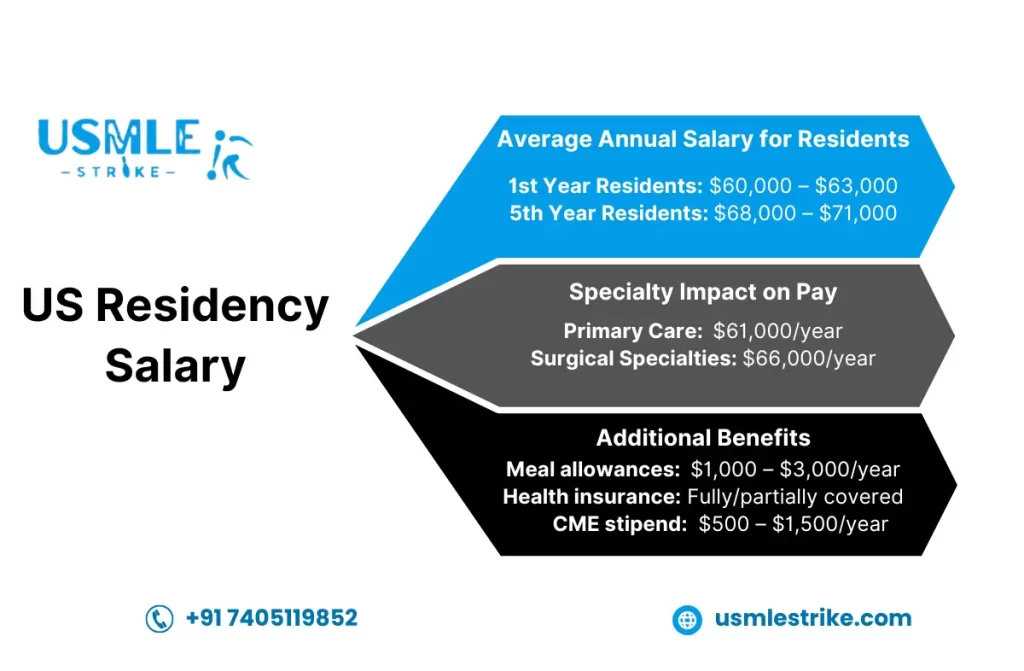The medical residency phase is one of the most challenging yet rewarding periods in a doctor’s career. However, understanding the US residency salary is critical to navigating this journey successfully. For aspiring doctors, questions around salaries during residency, benefits, and long-term career potential often arise. In this comprehensive guide by USMLE Strike, we will explore the nuances of US residency salary, the factors influencing pay, and strategies to manage your finances effectively during your training.
How Much Do Residents Make in 2025?
The average US residency salary for 2025 ranges between $60,000 and $75,000 (Rs. 51,88,650 to Rs. 60,53,237) annually. While this amount might seem modest considering the workload, it serves as a financial bridge during the medical training process.
Key Highlights:
- First-Year Residents: Typically earn $60,000 (Rs. 51,88,843).
- Incremental Pay: Salaries increase by $2,000–$5,000 (Rs. 1,72,961 to Rs. 4,32,423) annually with each additional year of residency.
- Hospital-Specific Benefits: Some programs offer perks like housing stipends or meal allowances.
For instance, a resident in a high-demand specialty might receive additional incentives, but these are exceptions rather than the norm.
Updated U.S. Medical Residency Salaries (2025–2026)
| Resident Job Title | Average Annual Salary (USD) |
|---|---|
| Resident PGY-1 | $63,009 – $78,540 |
| Resident PGY-2 | $66,092 – $82,500 |
| Resident PGY-3 | $69,136 – $86,350 |
| Resident PGY-4 | $71,979 – $90,750 |
| Resident PGY-5 | $74,786 – $95,150 |
| Resident PGY-6 | $77,276 – $99,000 |
| Resident PGY-7 | $79,938 – $104,500 |
| Resident PGY-8 | $83,918 – $110,000 |
How Much Are Residents Paid in the US?
Medical residents in the US earn a standardized stipend based on program structures, specialty, and geographic location. The residency pay in the USA generally provides enough to cover basic living expenses but not luxury spending.
Key Points:
- Residents work long hours, averaging 60–80 hours weekly.
- Hourly wages translate to approximately $15–$25 (Rs. 1,297 to Rs. 2,162).
- Specialties with intense workloads, such as general surgery, may offer slightly higher stipends.
The residency Salary in the USA reflects the educational nature of the training period rather than competitive professional salaries.
How Much Are Residents Paid Per Hour in the US?
Breaking down the US residency salary to an hourly wage gives a clearer perspective on compensation. With residents working extended hours, their effective hourly rate is modest.
Details:
- Residents often work 12–16-hour shifts, averaging 60–80 hours weekly.
- Hourly pay ranges from $15 to $25 (Rs. 1,297 to Rs. 2,162), depending on the specialty and region.
- Certain programs may offer overtime or bonuses for exceeding set hours, but this is uncommon.
Despite the long hours, this phase equips residents with the hands-on experience they need for future practice.
Does a Resident’s Salary Increase During Training?
Yes, residents experience incremental salary increases as they advance through their training years. These increments reflect the growing responsibilities and expertise of residents over time.
Annual Progression:
- First-Year Residents: $60,000 (Rs. 51,89,103)
- Second-Year Residents: $63,000 (Rs. 54,48,559)
- Third-Year Residents: $67,000+ (Rs. 57,94,499+)
Specialized programs may offer additional bonuses or allowances as residents progress, particularly in competitive fields like radiology or anesthesiology.
Are Medical Residents Paid Enough?
The adequacy of residency pay in the USA is a hotly debated topic. While salaries are designed to support basic living expenses, they often fall short of covering medical education loans, high living costs in urban areas, and other personal needs.
Challenges:
- Residents face significant financial stress due to low savings potential.
- In metropolitan areas, higher rent and transportation costs often strain limited incomes.
On the other hand, hospitals provide benefits such as subsidized housing, meal plans, and free medical insurance, which help offset some of these challenges.
Expected Salaries by Location
The US residency salary is significantly influenced by location. Urban areas with higher living costs tend to offer slightly higher salaries to balance expenses, while rural programs may have lower salaries but affordable living conditions.
Examples:
- New York City: Residents earn $73,000 (Rs. 63,13,513) annually but face high housing costs.
- Houston, Texas: Average salaries hover around $68,000 (Rs. 58,81,004), with moderate living expenses.
- Rural Areas: Salaries average $60,000 (Rs. 51,89,103), but reduced housing and transportation costs can make this more manageable.
Geographic preferences play a significant role when selecting a residency program.
Expected Salaries by Specialty
Specialty choice significantly impacts the residency salary in the USA. More demanding or highly specialized fields often offer higher salaries, reflecting their rigorous training requirements.
Specialty Salary Breakdown:
- Primary Care (Family Medicine, Internal Medicine): $60,000–$65,000 (Rs. 51,89,700 to Rs. 56,22,175) annually.
- Surgical Specialties (Orthopedics, Neurosurgery): $70,000+ (Rs. 60,54,650+) annually.
- Competitive Specialties (Dermatology, Cardiology): Up to $75,000 (Rs. 64,86,480) annually.
These salaries often correspond with the earning potential post-residency, making some fields more appealing to residents.

Expected Salaries by Gender
While the structured pay scales of residency programs minimize disparities, gender-based salary gaps may persist due to differences in negotiation strategies or biases within programs.
Insights:
- Male and female residents often report comparable base salaries.
- However, small gaps in additional stipends or bonuses can still arise.
Efforts are being made to standardize benefits and ensure fair compensation for all residents.
Post-Residency Salaries
After completing residency, physicians experience a substantial income boost. The US residency salary prepares residents for this leap, serving as a stepping stone to lucrative roles.
Post-Residency Earnings:
- Primary Care Physicians: $200,000–$250,000 (Rs. 1,72,97,117 to Rs. 2,16,21,864) annually.
- Specialists (e.g., Cardiology, Neurology): $300,000–$400,000 (Rs. 2,59,46,237 to Rs. 3,45,94,983) annually.
- Surgical Subspecialties: $500,000+ (Rs. 4,32,43,729) annually.
These figures highlight the long-term financial benefits of enduring the challenges of residency.
Can Residents Negotiate for a Higher Salary?
Negotiation is rare for residents due to standardized salaries across most programs. However, residents can advocate for additional benefits.
Negotiable Aspects:
- Housing stipends or reduced rent in hospital-owned housing.
- Reimbursements for certification exams or conference attendance.
- Travel allowances for rotations in different locations.
While the residency pay in the USA might feel rigid, exploring these options can help improve your financial position during training.
Planning Better as a Resident
Maximizing the US residency salary requires effective financial planning. By managing your expenses and leveraging available benefits, you can reduce financial stress and focus on your training.
Tips for Smart Financial Planning:
- Create a monthly budget that prioritizes rent, utilities, and groceries.
- Consider shared housing or hospital-provided accommodations to save costs.
- Take advantage of discounts or subsidies offered by your program.
With careful planning, even a modest salary can sustain you through residency.
Do You Get Paid During Residency?
Yes, all residents in the US are compensated throughout their training. The US residency salary includes base pay, benefits, and sometimes additional stipends for specific responsibilities.
What You Can Expect:
- Weekly or monthly paychecks.
- Benefits like health insurance, vacation days, and sick leave.
- Bonuses for attending workshops or certifications (in some programs).
Conclusion
The US residency salary is a cornerstone of the medical residency journey, offering a modest yet steady income to support residents through their training. While the pay might not match the intensity of the workload, it’s a crucial stepping stone toward a fulfilling and lucrative career in medicine. By understanding the salary structure, planning finances wisely, and exploring additional benefits, residents can navigate this challenging period successfully.





